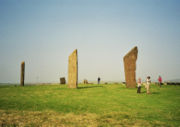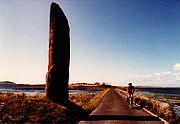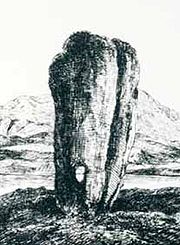
Stones of Stenness
Encyclopedia

Neolithic
The Neolithic Age, Era, or Period, or New Stone Age, was a period in the development of human technology, beginning about 9500 BC in some parts of the Middle East, and later in other parts of the world. It is traditionally considered as the last part of the Stone Age...
monument on the mainland of Orkney, Scotland
Scotland
Scotland is a country that is part of the United Kingdom. Occupying the northern third of the island of Great Britain, it shares a border with England to the south and is bounded by the North Sea to the east, the Atlantic Ocean to the north and west, and the North Channel and Irish Sea to the...
. Various traditions associated with the stones survived into the modern era and they form part of the Heart of Neolithic Orkney World Heritage Site
World Heritage Site
A UNESCO World Heritage Site is a place that is listed by the UNESCO as of special cultural or physical significance...
. They are looked after by Historic Scotland
Historic Scotland
Historic Scotland is an executive agency of the Scottish Government, responsible for historic monuments in Scotland.-Role:As its website states:...
.
Layout and location
The surviving stones are sited on a promontory at the south bank of the stream that joins the southern ends of the sea loch Loch of StennessLoch of Stenness
The Loch of Stenness together with the Loch of Harray are the two largest freshwater lochs of Mainland, Orkney. In Old Norse their names are Steinnesvatn and Heraðvatn...
and the freshwater Loch of Harray. The name, which is pronounced stane-is in Orcadian dialect, comes from Old Norse
Old Norse
Old Norse is a North Germanic language that was spoken by inhabitants of Scandinavia and inhabitants of their overseas settlements during the Viking Age, until about 1300....
meaning stone headland. The stream is now bridged, but at one time was crossed by a stepping stone causeway, and the Ring of Brodgar
Ring of Brodgar
The Ring of Brodgar is a Neolithic henge and stone circle on the Mainland, the largest island in Orkney, Scotland...
lies about 1.2 km (3/4 mile) away to the north-west, across the stream and near the tip of the isthmus formed between the two lochs. Maeshowe
Maeshowe
Maeshowe is a Neolithic chambered cairn and passage grave situated on Mainland, Orkney, Scotland. The monuments around Maeshowe, including Skara Brae, were designated a UNESCO World Heritage Site in 1999. It gives its name to the Maeshowe type of chambered cairn, which is limited to Orkney...
chambered cairn is about 1.2 km (3/4 mile) to the east of the Standing Stones of Stenness and several other Neolithic monuments also lie in the vicinity, suggesting that this area had particular importance.

Neolithic
The Neolithic Age, Era, or Period, or New Stone Age, was a period in the development of human technology, beginning about 9500 BC in some parts of the Middle East, and later in other parts of the world. It is traditionally considered as the last part of the Stone Age...
Barnhouse Settlement
Barnhouse Settlement
The Neolithic Barnhouse Settlement is sited by the shore of Loch of Harray, Orkney Mainland, Scotland, not far from the Standing Stones of Stenness. It was discovered in 1984. The base courses of at least 15 houses have been found...
which has been found adjacent to the Loch of Harray. The Watch Stone stands outside the circle to the north-west and is 5.6 m (18 ft) high. Other smaller stones include a square stone setting in the centre of the circle platform where cremated bone, charcoal and pottery were found, and animal bones were found in the ditch. The pottery links the monument to Skara Brae
Skara Brae
Skara Brae is a large stone-built Neolithic settlement, located on the Bay of Skaill on the west coast of Mainland, Orkney, Scotland. It consists of ten clustered houses, and was occupied from roughly 3180 BCE–2500 BCE...
and Maeshowe, and the site is thought to date from at least 3000 BC.
Traditions

Walter Scott
Sir Walter Scott, 1st Baronet was a Scottish historical novelist, playwright, and poet, popular throughout much of the world during his time....
in 1814. Other antiquarians documented the stones and recorded local traditions and beliefs about them. One stone, known as the "Odin
Odin
Odin is a major god in Norse mythology and the ruler of Asgard. Homologous with the Anglo-Saxon "Wōden" and the Old High German "Wotan", the name is descended from Proto-Germanic "*Wodanaz" or "*Wōđanaz"....
Stone" was pierced with a circular hole, and was used by local couples for plighting engagements by holding hands through the gap. It was also associated with other ceremonies and believed to have magical power.
In December 1814 Captain W. Mackay, a recent immigrant to Orkney who owned farmland in the vicinity of the stones, decided to remove them on the grounds that local people were trespassing and disturbing his land by using the stones in rituals. He started in December 1814 by smashing the Odin Stone. This caused outrage and he was stopped after destroying one other stone and toppling another.
The toppled stone was re-erected in 1906 along with some inaccurate reconstruction inside the circle.
Natural features
There is significant birdlife present in the lochLoch
Loch is the Irish and Scottish Gaelic word for a lake or a sea inlet. It has been anglicised as lough, although this is pronounced the same way as loch. Some lochs could also be called a firth, fjord, estuary, strait or bay...
s on either side of this site. About two miles (3 km) to the south is the Burn of Ayreland
Burn of Ayreland
The Burn of Ayreland is a northwesterly flowing coastal stream on Mainland Orkney, Scotland that discharges to the Clestrain Sound about two miles south of Stenness. Draining chiefly agricultural lands elevated mosses and moorland. This stream has a notable lack of turbidity and a pH level of...
as it discharges to the Clestrain Sound
Clestrain Sound
Clestrain Sound is a strait between Mainland Orkney and the Isle of Graemsay within the Orkney Islands, Scotland.Clestrain Sound lies in the western entrance to Scapa Flow. Like other seaways within the Orkney Islands, Clestrain Sound has been recognized for many years to be warmed by the North...
.
World Heritage status
‘The Heart of Neolithic OrkneyHeart of Neolithic Orkney
Heart of Neolithic Orkney refers to a group of Neolithic monuments found on the Mainland, one of the islands of Orkney, Scotland. The name was adopted by UNESCO when it proclaimed these sites as a World Heritage Site in 1999....
’ was inscribed as a World Heritage site in December 1999. In addition to the Standing Stones of Stenness, the site includes Maeshowe
Maeshowe
Maeshowe is a Neolithic chambered cairn and passage grave situated on Mainland, Orkney, Scotland. The monuments around Maeshowe, including Skara Brae, were designated a UNESCO World Heritage Site in 1999. It gives its name to the Maeshowe type of chambered cairn, which is limited to Orkney...
, Skara Brae
Skara Brae
Skara Brae is a large stone-built Neolithic settlement, located on the Bay of Skaill on the west coast of Mainland, Orkney, Scotland. It consists of ten clustered houses, and was occupied from roughly 3180 BCE–2500 BCE...
, the Ring of Brodgar
Ring of Brodgar
The Ring of Brodgar is a Neolithic henge and stone circle on the Mainland, the largest island in Orkney, Scotland...
and other nearby sites. It is managed by Historic Scotland, whose 'Statement of Significance' for the site begins:
The monuments at the heart of Neolithic Orkney and Skara Brae proclaim the triumphs of the human spirit in early ages and isolated places. They were approximately contemporary with the mastabas of the archaic period of Egypt (first and second dynasties), the brick temples of Sumeria, and the first cities of the Harappa culture in India, and a century or two earlier than the Golden Age of China. Unusually fine for their early date, and with a remarkably rich survival of evidence, these sites stand as a visible symbol of the achievements of early peoples away from the traditional centres of civilisation...Stenness is a unique and early expression of the ritual customs of the people who buried their dead in tombs like Maes Howe and lived in settlements like Skara Brae.

